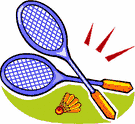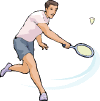Lesson
- Badminton
Let's first look at the history behind this fantastic
sport, followed by some simplified rules, types of shots, basic strategy
in both singles and doubles play, and finally the dimensions and boundaries
of the court.
History
-
English
officers played "Poona" in India during the seventeenth century.
-
Poona was
later played at Badminton, the home of the Duke of Beaufort, in
1873...thus resulting in the present name we use today.
-
The term serve comes from when English royalty played badminton and
their servants would hit the shuttlecock to start play.
-
English settlers brought badminton to America.
-
Played
by 2 to 4 players on varying court sizes
- Badminton has
become a highly skilled, competitive sport.
- Badminton was
introduced as a full-medal Olympic sport in 1992.
Simplified
Rules
Net - 5'1'' at posts, 5' at center Players spin a
racquet or toss a coin to determine who gets serve or side.Scoring
Games and Match - Ladies singles, ladies doubles and mixed
doubles - 3 x 11 points, men's doubles and men's singles
- 3 x 15 points,
(A match is 2 out of 3 games.)
Scoring - points are only scored by the
player or the side which is serving. Each
player
continues to serve, alternating courts,
until she/he or her/his side commits an
error or fault. Setting
- Length of the game can be extended by setting when the
score is tied near the end of the game. At 14-all, the set is three.
The side which
first reached 14 can choose either to play to 15, or to set the game
to 3 and play to 17 points.
In Ladies singles, doubles, and mixed, 11 points wins a game and there is the
option of setting to 2 at 10-10. This means the game would be extended to 12
points.A set game continues
as previously, but the score is now called "love all" (zero
to zero). The first side or player to reach the set score wins the
game.
Serving
Singles - Service is from the right court
when the score is even or zero. Service
is from
left court when the score is odd.
Doubles - The player who starts serving
for a team will always serve from the
right side
when the score is even and from the
left side
when the score is odd. Their partner
will do the opposite. In doubles, the
first serve is always started form
the right court whenever a team acquires
the serve from its opponents. The server
will alternate service courts each
time a point is made until the serve
is lost.
The side serving first in the game has
only one term of service in the first
inning. If the serving team commits a
fault in
the
first
inning, 'side-out' is called.
Throughout the following inning, each
partner on each side has a turn at service.
Whenever a side becomes the serving side,
the partner in the right hand court serves
first.
The partners rotate courts only
after
winning a point.
If you started the game in the right
court, you should be in this court whenever
the
score for your team is 0 or even.
The shuttle must be served
diagonally across court into the
correct service area
(refer to diagrams for singles
and doubles
service courts).
Upon contact, the head of the racquet must be below the waste. In singles, the
shuttle must land in the long, narrow court. In doubles, it must
land in the short, wide court. However, in doubles, once
the serve has been returned, the full court is used.
Any shuttle hitting
the line is in bounds.
Server's and receiver's feet must
be within their service court
and in contact
with
the ground at the time of service.
Server may not serve again if
she completely misses the shuttle
on
the service attempt.
It is a fault.
If the serve contacts the net
and lands in the proper area,
it is
considered 'good'.
A 'let' or reserve is called
if the receiver is not ready
for the
serve,
or if the
bird at any time crosses the
net and becomes
tangled
in the
net, not falling to the floor.
.
Badminton Faults
and Lets
A fault is any
error that ends play, whether occuring during the serve or the rally.
A fault committed by the serving side gives the serve to the opponent.
A fault committed by the receiving side gives the point to the server.
Service Faults:
Receiving Faults:
-
The receiving
player is not standing in the correct service court.
-
The receiving
player moves before the serve is made.
Faults that Can
Be Committed During Rallies:
-
The shuttle touches
the ground inbounds.
-
The opposition
does not return the shuttle.
-
The shuttle falls
outside the playing court.
-
A player blocks
the opponent's play.
-
A player and/or
partner hits the shuttle more than once before returning it over
the net.
-
A player touches
the net with his or her body or racquet.
-
A player reaches
over the net ot play the shuttle.
-
-
A let occurs when
a point does not count and must be replayed.
-
-
Serves are taken
out of turn.
-
Serves are taken
before the receiver is ready.
Rallies are won
after:
-
Serving from the
wrong court.
-
Faults occur simultaneously
by both sides.
-
The shuttle becomes
stuck in the net after crossing.
General Rules A shot during
a rally which touches and
passes over the
net and falls
within the legal boundary
lines is considered good. Players must change
sides of the court after each gameThe winner of
the previous games serves the next game.A match is the
best of three games.
|
 Unit
3: Games
Unit
3: Games
